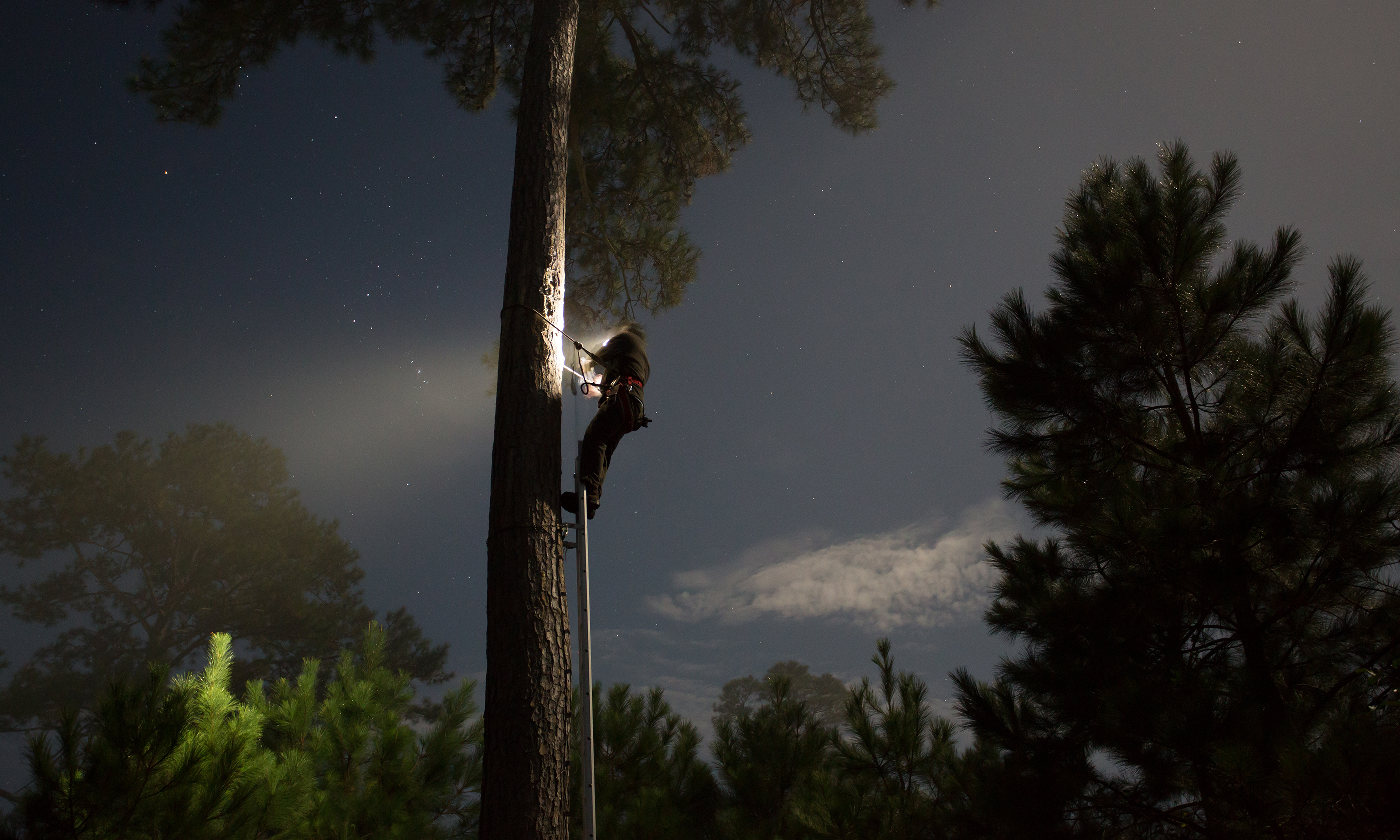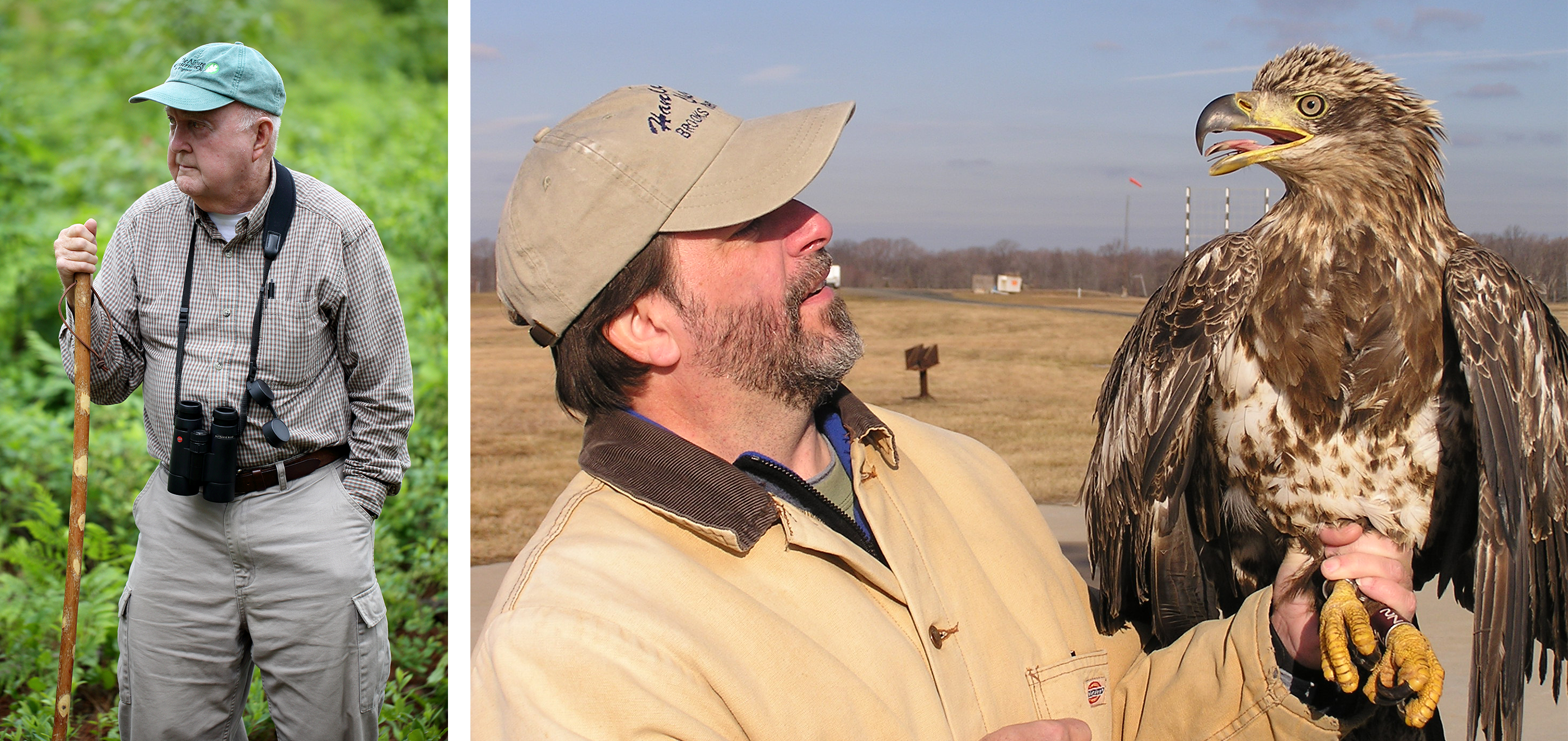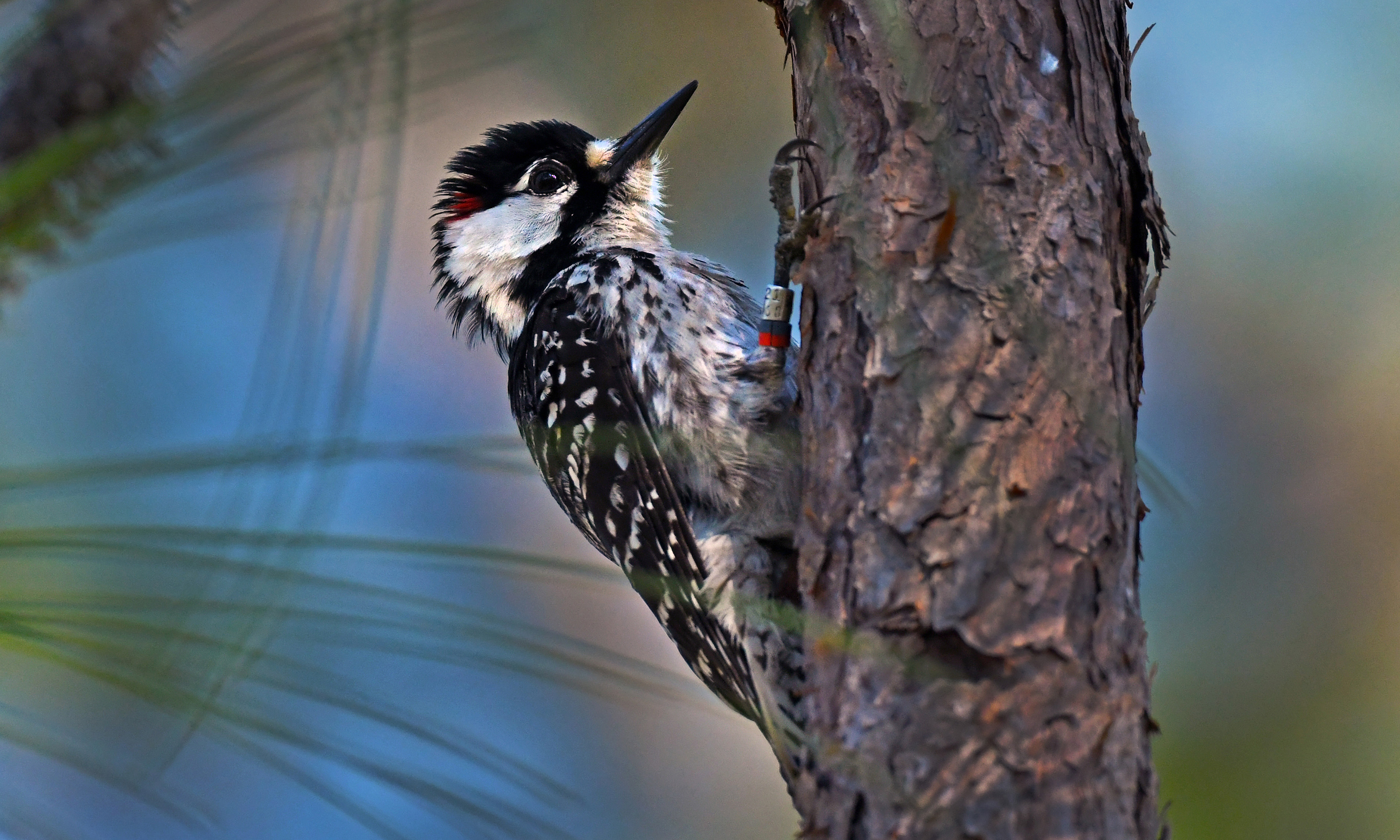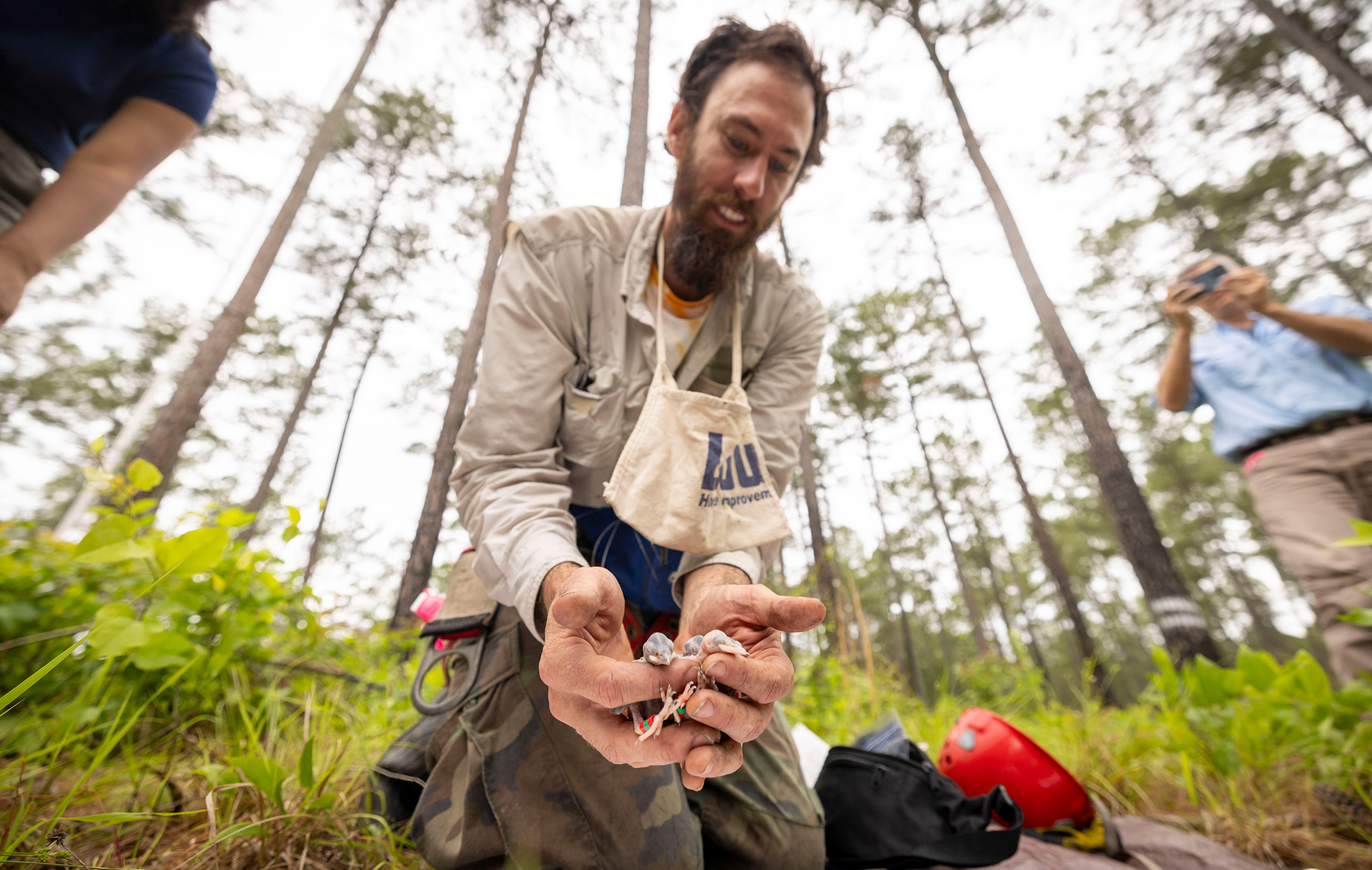Back from the Brink
The revival of Virginia's red-cockaded woodpecker population is just one of the success stories for W&M's Center for Conservation Biology
October 1, 2025
By
Annie Powell M.A. ’18, Ph.D. ’24
On a drizzly morning in May, Chance Hines, a research biologist with William & Mary’s Center for Conservation Biology, climbed 60 feet up a 120-foot-tall loblolly pine tree in search of red-cockaded woodpecker chicks. He found four chicks in a nest cavity in that tree. After removing them one by one, to the dismay of their circling parents, Hines placed them in a sack around his neck and climbed back down.
At 6 days old, the chicks looked like tiny ancient Pteranodons — featherless, with protruding wings, legs and necks. Their eyes, not yet open, could be seen under translucent skin. With time, the chicks will develop black and white feathers, with a characteristic red stripe, or “cockade,” along the side of the males’ heads.
Hines’ temporary removal of the blind, helpless chicks from their nest was in the service of a higher purpose — to save the red-cockaded woodpecker from extinction. Such efforts are working. The species, previously listed as “endangered” under the Endangered Species Act of 1973, was downlisted to “threatened” by the U.S. Fish & Wildlife Service in October 2024. (It retains the “endangered” classification in Virginia.) Down to two breeding pairs 20 years ago, there are now over 100 red-cockaded woodpeckers in the state.
“The reclassification is indicative of successful conservation activities,” Hines says.
Those conservation activities include monitoring the red-cockaded woodpecker population and revitalizing the birds’ habitat of old-growth pine forests. That work has emerged largely from a successful partnership between the Center for Conservation Biology (CCB), which manages the population as part of its mission to restore the at-risk avian species, and The Nature Conservancy, which manages the habitat. The U.S. Fish & Wildlife Service, the Virginia Department of Wildlife Resources and the Virginia Department of Conservation and Recreation are also partners in the endeavor.
The CCB has become a nationally preeminent center of avian research and conservation since its establishment in 1992, serving as a resource of reliable information for the conservation community and as a trusted advisor to government and nongovernment agencies. With a permanent staff of seven, plus graduate and undergraduate students, the CCB runs a robust research program, trains the next generation of scientists and educates the public on the importance of conservation.

THE BYRD LAB
William & Mary’s numerous successes in bird conservation began with a Byrd — Chancellor Professor Emeritus Mitchell Byrd, a beloved professor in the biology department from 1956 to 1995. His research, teaching and mentorship initiated the conservation work that would flourish at William & Mary through the Center for Conservation Biology.
Byrd arrived at W&M after graduate school and a stint in the military, working at what was then called the U.S. Army Biological Warfare Laboratories at Fort Detrick in Frederick, Maryland, with diseases such as bubonic plague and a variety of parasites. In his academic career, he initially approached birds from a pathology background: For about two years, he worked on a study of the leucocytozoon parasite in wild turkeys. By the 1970s, he was engaged in conservation work in earnest.
From then on, the Byrd lab became, truly, the bird lab.
Bryan Watts M.A. ’87, director of the CCB and the Mitchell A. Byrd Research Professor of Conservation Biology, was one of Byrd’s graduate students. He studied night herons in Byrd’s lab before earning a doctorate at the University of Georgia.
In the 1990s, Watts and Byrd worried that the research and conservation programs headquartered at the Byrd lab would disappear upon Byrd’s retirement. So they wrote a proposal to then-Provost Melvyn D. Schiavelli to establish a center that would ensure Byrd’s work would carry on. The proposal was approved, and the CCB was established in 1992 with Watts as director.
“The initial objectives were to continue a lot of the legacy programs that had been going on for decades,” Watts says. “But the Center has expanded well beyond that. We’ve worked with hundreds of species throughout the Western Hemisphere, from the high Arctic down to Argentina.”
The CCB has become an essential part of bird conservation in Virginia. With researchers working on about 40 field projects per year, Watts estimates that the CCB has conducted about 1,000 projects since its inception.
“Mitchell has been involved and has been at the foundational level of many conservation programs over the decades,” Watts says. In the 1970s, for example, Byrd was part of the reestablishment of the peregrine falcon population in Virginia as well as the Chesapeake Bay bald eagle recovery team.

“We’ve been close friends and colleagues for decades,” says Watts. “He’s a Southern gentleman with an incredible wit, and so students really loved him. There are people all over the country that still contact me about Mitchell.”
That feeling of respect is mutual. Byrd loved teaching and working with students, and he calls Watts the best graduate student he ever had. “It was obvious from two weeks in that he was pretty exceptional, and that’s proven to be the case,” Byrd says.
One of the most valuable aspects of the CCB is its institutional memory, with generational datasets that go back decades. Those datasets, many of which Byrd created, are critical resources for the conservation community across the U.S and have made the CCB a preeminent center for information and expertise. Their high value stems from the fact that most successful conservation work entails long-term commitments.
The red-cockaded woodpecker is one of those long-term commitments. Byrd conducted the first systematic survey in Virginia on the species in 1978, working alongside his graduate student Gary Miller ’76, M.A. ’79, who became the 18th president of The University of Akron before retiring in 2024.
“When you’re in the conservation business for decades, you realize that the success or failure of these projects comes down to commitment. For the red-cockaded woodpeckers, The Nature Conservancy has been committed to the habitat, William & Mary has been committed to the population, and both of those things combined have led to the success that we’ve had,” says Watts.

A RARE BIRD
Eating breakfast at the Virginia Diner in Wakefield during his early days surveying the species, Byrd saw a logging truck drive by with a red-cockaded woodpecker cavity in one of the logs. “That was rather upsetting,” he says.
Habitat loss, primarily through logging, devastated the red-cockaded woodpecker species in the 20th century. The birds’ original habitat spanned from New Jersey south to Florida and west to Texas. But decades of logging practices, combined with a national policy of fire suppression, reduced their numbers significantly: By 2002, only two breeding groups were left in Virginia, according to The Nature Conservancy.
Considered a “keystone species” by the Virginia Department of Wildlife Resources, red-cockaded woodpeckers are an essential part of the Southeast’s pine forest ecosystem. They adapted to the region’s historically frequent lightning fires, preferring to create nesting cavities in live pine trees (the only woodpecker species to do so) since dead trees are usually destroyed in fires. With a reduction in naturally occurring fires over time, deliberately planned and carefully supervised fires known as prescribed burns help to restore the habitat where the birds thrive by thinning out forest growth.
The birds “are constantly working on creating new cavities and often abandon older cavities after new ones are completed,” Hines says. “These abandoned cavities provide nesting cavities for many other nesting birds as well as reptiles, amphibians and mammals. Because of this, the animal diversity at sites with red-cockaded woodpeckers is really great.”
Red-cockaded woodpeckers can work for two years to create a nesting cavity in a live tree, an enormous investment of time and energy. They choose trees infected by heart rot fungus, which eats through the middle of a tree, creating hollow portions in the center. Pecking through to the hollow center of the infected tree, red-cockaded woodpeckers create their nests on the solid bottom of a hollow portion. Other animals (“secondary cavity users,” Watts calls them) often try to take advantage of the woodpeckers’ hard work.
“Their behavior evolved to be very protective of that cavity,” says Bobby Clontz ’89, a former undergraduate student of Byrd’s and now the statewide fire manager and long leaf pine specialist at The Nature Conservancy.
Southern flying squirrels are one of the main competitors for the cavities built by red-cockaded woodpeckers. Those competitors are nocturnal, active during the night and finding somewhere to rest when the sun comes up. To prevent the squirrels from taking their nests, red-cockaded woodpeckers have developed an efficient strategy — sleeping in.
“If you’ve ever been out at the crack of dawn and heard birds singing, that chorus doesn’t usually include red-cockaded woodpeckers,” Clontz says.
Recognition of Excellence
Bryan Watts M.A. ’87, director of William & Mary’s Center for Conservation Biology, received the prestigious Eisenmann Medal this year for his contributions to ornithology.
By staying in their nests a little longer in the morning, the woodpeckers force their nocturnal nesting competitors to find another place to spend the day and therefore hold on to their hard-earned cavities.
The species’ family system is also unique. As cooperative breeders, a family group consists of a pair of breeders and an assortment of helpers. The largest family group recorded at The Nature Conservancy’s Piney Grove Preserve consisted of nine members, according to Clontz.
They function more like a human family than other comparable bird species, says Dan Cristol, Chancellor Professor of Biology and director of the 1693 Scholars Program.
“The pace of their life is more human, where they’re waiting around for years to be able to buy their own home and move in down the street from their parents.” According to Cristol, that’s not the way most similar bird species live. “Most birds leave their parents when they’re 3 months old and never see them again. Their parents chase them away, and they settle down somewhere else, and that’s that.”
This rare breeding strategy likely developed because of spatial constraints. Without enough habitable territory for the progeny to create their own nests, they remain in the familial orbit.

RECENT REVIVAL
Collaboration between university, federal, state and private organizations has saved the red-cockaded woodpecker species. Thanks to the CCB’s monitoring of the population and its partners’ revitalization of the landscape, the number of red-cockaded woodpeckers in Virginia has increased to well over 100.
Such success does not mean that conservation efforts on behalf of the species will stop, however. “The downlisting from endangered to threatened will mean that there will be more flexibility for managers or industries that interact with the species. But the red-cockaded woodpecker habitat will still require management to sustain the existing population,” Hines says.
Cristol considers red-cockaded woodpeckers an ideal subject to study and teach. “They show how nature is connected, where it takes a bird, a tree, a fungus, all the insects the bird eats and fire to keep the trees the right size. It’s just an unbelievable system.”
He is passionate about sharing that sense of natural wonder with students and alumni, offering courses in ornithology, directing student research and guiding birding tours at alumni events.
There is definite interest in bird science and bird watching. A recent study by the U.S. Fish & Wildlife Service concluded that nearly 100 million people in the U.S. are birdwatchers — more than 35% of the adult population.
A widespread interest in the welfare of bird populations will help their preservation. Watts, who has seen bird populations fall and rise and fall again, is optimistic about the future of bird conservation.
“We have so many young people who are so sophisticated who have trained at William & Mary and elsewhere, and these are the people that are going to meet the challenges that will come down the road.”
Cristol’s outlook is a little less bright: “I’m optimistic that we will save lots of nature,” he says. “I’m also quite certain that we’re going to live on a very diminished planet. We actually already do, but people don’t realize it because it happens so gradually. My children will not be able to show their children nearly as much amazing stuff as I have been able to show them.”
But it’s important to remember, Cristol says, that conservation work has seen great improvements. Seagulls, for example, almost endangered at the turn of the last century from a demand for seagull feathers in hats, are now pests for beachgoers.
Watts highlights similar achievements from the work of the CCB. “We’ve had some tremendous successes,” he says. “We’ve reestablished peregrine falcons in the state, we’ve recovered bald eagles. Most of these vulnerable species face a long parade of challenges and so you need to be consistently vigilant about what’s happening within the population. That’s been a strength of the Center.”
THE CHICKS OF THE FUTURE
Back at the Piney Grove Preserve in May, before Hines returned the collection of chicks to their nest 60 feet above the forest floor, he and Clontz had work to do.
As Hines removed the chicks from the sack, he and Clontz weighed them (about 2 ounces each), estimated their age (about 6 days old) and recorded the measurements. Then, for each chick, Hines secured three colored bands around one leg and a single colored band and a single metal band around the other leg, which will serve as identification tools for researchers as the chicks advance to adulthood. The metal band even includes a unique ID number issued by the federal government.
These four chicks will face numerous challenges as they grow up — finding food, sheltering from weather and predators and attracting a mate. But, although they don’t know it, the chicks have teams of people on their side, working hard to ensure their successful addition to a thriving red-cockaded woodpecker population in Virginia.